Key digested message
This article explores the personality traits that can potentially derail public sector Chief Executives (CEOs), using data from the Hogan Development Survey (HDS). It aims to understand which behaviours correlate with leadership success or failure in the public sector.
Notably, nearly half of the CEOs assessed exhibited no high-risk derailers, indicating a high degree of stability and consistency in their leadership profiles. When compared to global and private sector benchmarks, public sector CEOs appear to be less susceptible to derailment.
Among those who did present high-risk derailers, the most common was imaginative, highlighting a tendency toward curiosity and agility; qualities that, while valuable, may lead to impracticality if not well-managed. Additionally, high bold emerged as significantly more prevalent among unsuccessful candidates, suggesting that overconfidence and resistance to feedback may be detrimental to securing public sector CEO appointments.
This article was first featured in Assessment & Development Matters, published by The British Psychological Society.
Introduction
Against a backdrop of political, economic and social disruption across public services, when service transformation is essential, we aimed to better understand the leadership behaviours most likely to correlate to success or failure.
Public sector leadership has been specifically examined in research, frequently referencing transformational or engaging leadership as key for both overall organisational success (e.g. Alimo-Metcalfe & Alban-Metcalfe, 2006), and/or wellbeing and motivation of employees (Alimo-Metcalfe et al 2008). Some studies have also touched on leadership derailers for senior public sector leaders (e.g. Koolma & Dreven, 2019).
Most research on senior public leaders is limited by small sample sizes; by necessity, studies typically group all leadership levels together or examine Chief Executives in the private sector. This indicates a critical research gap regarding leadership behaviours of public sector Chief Executives and their impact on success or failure.
This research uses substantial data gathered by practitioners specialising in public sector leadership assessment and offers a unique opportunity to examine public sector CEO behavioural data on a large scale, identifying strengths and risks versus established leadership models and predicted future challenges for the sector.
This paper focuses specifically on leadership derailers, as measured by the Hogan Development Survey (HDS).
The Public Service landscape
It is useful to examine the context of the challenges which are specific to CEOs in public service as these can, and do, differ substantially to those faced in private sector organisations, by virtue of the nature of public service organisations and the context within which they operate.
Following discussions with leaders, our data exploration and examination of more widespread research and commentary, we can distil the challenges facing CEOs and use these to contextualise and frame the insights and discussion in this paper – they include:
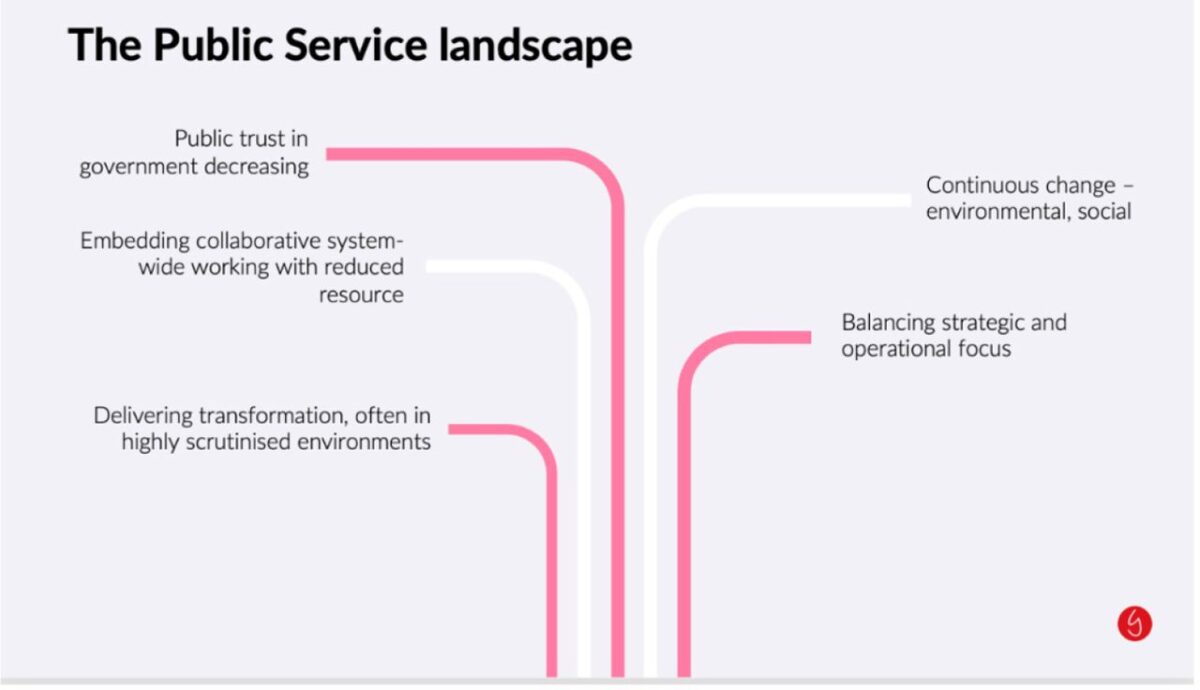
-
The need for CEOs to engender trust at a time when public trust is low – recent ONS stats show that the 70% of the public generally trust other people, but only 34% and 27% trust local and UK government leaders respectively.
-
The challenge of collaborative working across other public sector and private sector organisations, requiring CEOs to navigate a complex system with shared objectives and limited resources.
-
The CEO as the leader of a ‘dynamic movement’, both inspiring and connecting others through change whilst staying close to the operational detail.
The sample
Our sample consists of a mixture of CEOs and those reaching the final panel stage of CEO recruitment processes from across public service organisations, incorporating local and central government, the NHS, Emergency Services, Housing, Regulatory bodies, Professional Membership organisations and Not for Profit organisations/charities. Hereafter, this group is referred to as Chief Executives for ease.
Derailer data is available for 445 Chief Executives. For comparison purposes we also examined data from 1275 Directors (those currently in or reaching final panel stage for any other Executive level role).
Various analyses were performed to compare the HDS profiles of the CEOs with those of the most recent global sample assembled by the test publishers. This global sample consists of 115,793 people using one of 48 translations and originating from one of 190 counties or territories. The data was collected between 2018 and 2022 and was carefully stratified for even representation between job category, assessment purpose, age group and gender.
Method
The Hogan Development Survey (HDS) is a personality questionnaire focusing on 11 dispositions that may generally be considered desirable but that may flip into counterproductive mode if not managed well. These derailer qualities typically become apparent during novel or stressful periods, or when the individual feels relaxed or invulnerable. Combined with an individual’s imprecise beliefs about the way these behaviours impact on others, they may undermine loyalty and commitment from others and negatively influence careers.
The HDS is used extensively in high level selection processes, leadership development and executive coaching. The 11 scales of the HDS factor analyse into three main clusters – the first five scales (Excitable through Leisurely) form the Moving Away cluster, the next four (Bold through Imaginative) form the Moving Against cluster, and the last two (Diligent and Dutiful) form the Moving Towards cluster. Each cluster represents a characteristic style of coping with anxiety or insecurity, particularly apparent in social situations; the Moving Away cluster refers to withdrawing or detaching from others, Moving Against describes acting persuasively, or competitively, and Moving Towards is all about compliance and seeking approval and connection with others.
While not the focus of this paper, data are also available from Saville Consulting’s Wave and GatenbySanderson’s proprietary leadership behavioural framework, Altitude; these are referenced where useful insights can be provided to further understand and explore the impact of the derailers identified.
The findings
1. Number of high risk HDS behaviours in CEOs (Tables 1 and 2)
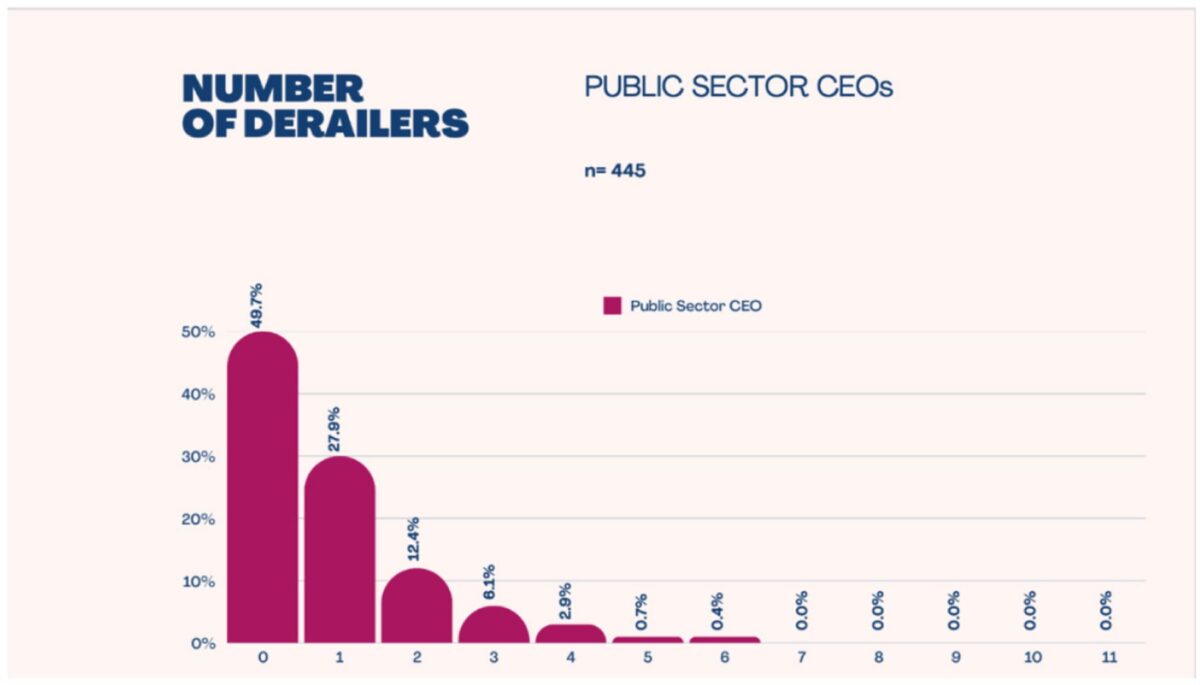
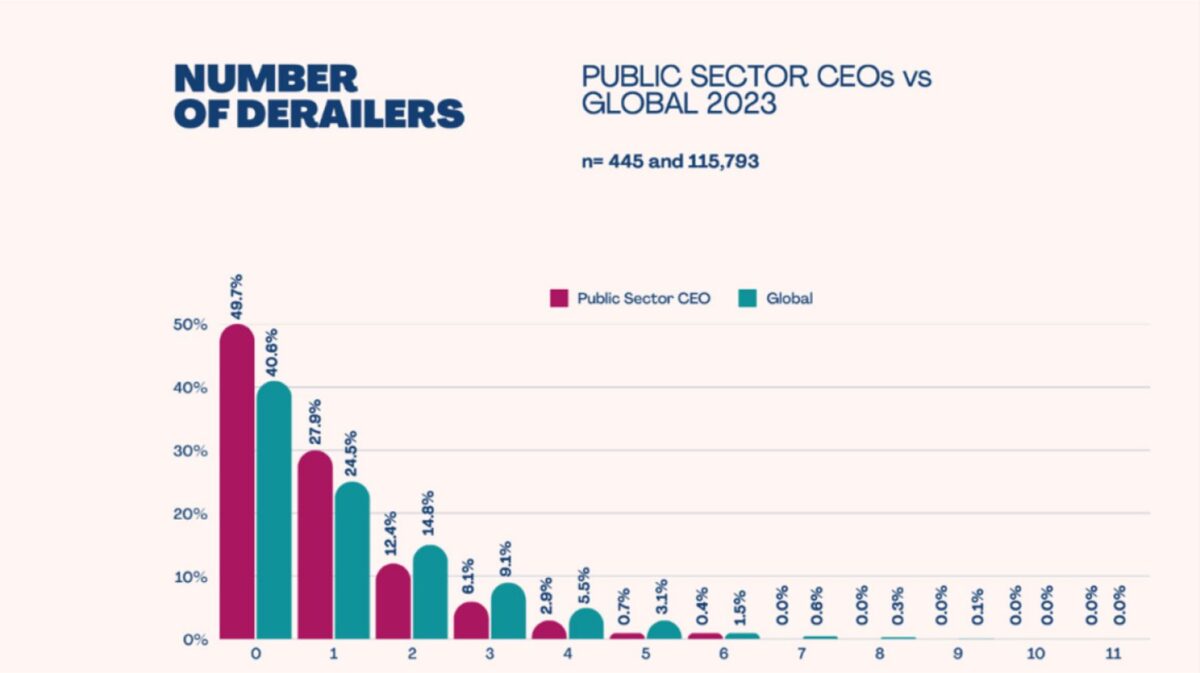
Before looking at the HDS scales in detail, it is useful to take a high-level overview of the number of derailers found in the CEO sample. Here, a derailer is defined as an HDS scale with a score at the 90th percentile or above.
While it is theoretically possible to have a high risk on all 11 HDS scales, it is extremely rare. Almost 50% of our CEO group showed zero derailers, meaning they had no high-risk scores at all on the questionnaire. This points to stable, consistent leadership, whatever the environment these public sector leaders are placed in. It also suggests that the earlier stages of the recruitment process are effectively identifying those with a greater risk profile and screening them out.
For comparison, the graph below shows the number of derailers found in the Global sample compared to those in this CEO sample. The pattern is very similar but the public sector CEOs have a noticeably higher incidence of having no derailers than do the Global sample; strengthening the interpretation that this group are particularly consistent and stable.
2. CEOs’ HDS high risk scores – which derailer is most prevalent? (Tables 3 and 4)
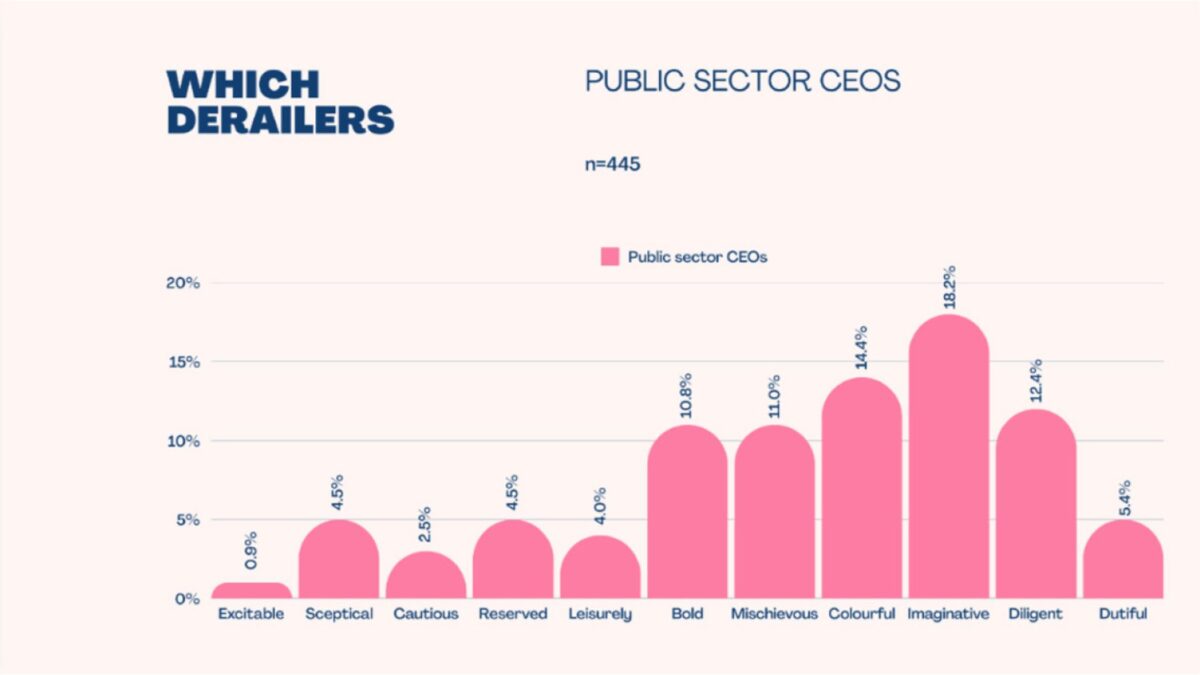
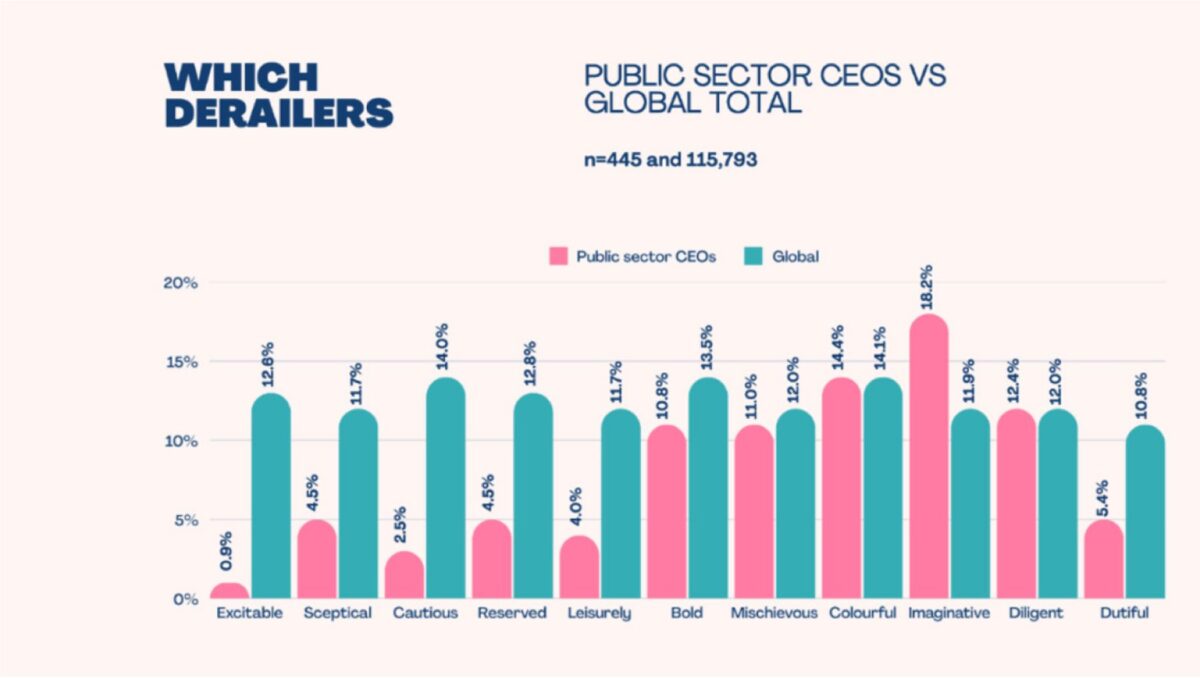
Imaginative stands out as the most frequently seen risk amongst Chief Executive shortlisted applicants with 18% displaying this behavioural risk.
When we compare this profile with the Global sample, we see high scores on Imaginative are much more prevalent in this CEO sample (18.2%) than in the Global sample (11.9%). While Colourful is the second most common derailer for the CEO group, it is no more prevalent here than in the total global sample.
While the upsides of Imaginative link to being inventive, ideas oriented and more strategic, the potential downside can be an over confidence in problem solving, a belief that others can’t understand complex issues in the same way or taking an unfocused approach that fails to deliver.
We also see the public service CEO sample as being much lower than the global sample on all five scales in the first Moving Away cluster of the HDS – adding even more strength to the ‘consistency’ of this sample – and also being lower on HDS Dutiful. Perhaps this profile is to be expected in those who have reached such levels of seniority; the Moving Away cluster of scales relates to themes of anxiety and insecurity that interfere with the ability to relate successfully with others, and a tendency to withdraw from others at times of stress or pressure, while the Dutiful scale is linked to acquiescence, a characteristic that may be unhelpful at this level of seniority.
It does also beg the question whether there is a degree of self-selection, with those who have higher scores in the Moving Away cluster choosing not to work in the Public Sector but perhaps choosing less conventional working environments where their style of behaviour is likely to be more tolerated. The assumption being that most organisations, including the public sector, tend to reward those who put themselves forward, who speak up, who engage readily with others, who are calm and consistent. Those who have higher scores in the Moving Away cluster might find a more comfortable home working in environments where their particular specialism or expertise is their advantage and their less socially skilled attributes are more tolerated.
The higher scores on HDS Imaginative tie in with our competency-based scoring of these individuals using Wave scores and validation conversations linked to Gatenby Sanderson’s Altitude leadership model – Being Curious and Agile was one of the top three strengths for this group, with 50% showing a strength in this area and only 8% being classified as having a weakness or risk. This competency is about personal intellectual curiosity and interest and a willingness to learn and try new things.
Interestingly though, our competency Tackle Tomorrow, which focuses on the practical application of these skills, while not coming out as an outright weakness, was one of the bottom three areas for the group – with 38% showing a strength and 18% a weakness. Note, this is against competency scores validated through a targeted discussion/interview which will have included reference to the Hogan results and exploration of them with the individuals.
This indicates that the curiosity and agility that public sector CEOs display to drive innovation and anticipate change is a strength, but, for some, the risk may be that they over rely on this strength – and potentially don’t take others on the journey, or pay insufficient attention to the practicalities.
Image 2 provides a summary of the key findings from analysing the HDS profiles of the CEO sample and comparing them to a global sample.
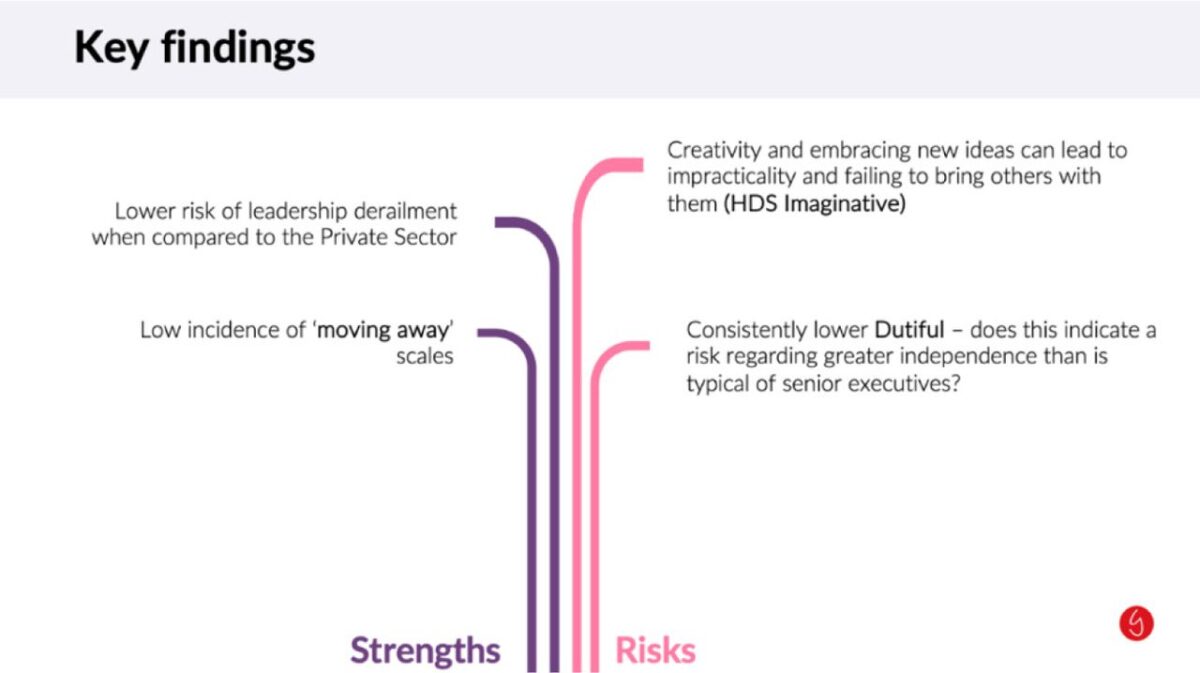
Further comparative analysis
We also carried out other comparison analyses to examine:
-
Whether there are distinctive features of public sector CEOs as compared to other public sector executive level leaders.
-
Whether derailers can help us identify which senior leaders are most likely to be offered the CEO role.
3. CEOs vs Directors (Table 5)
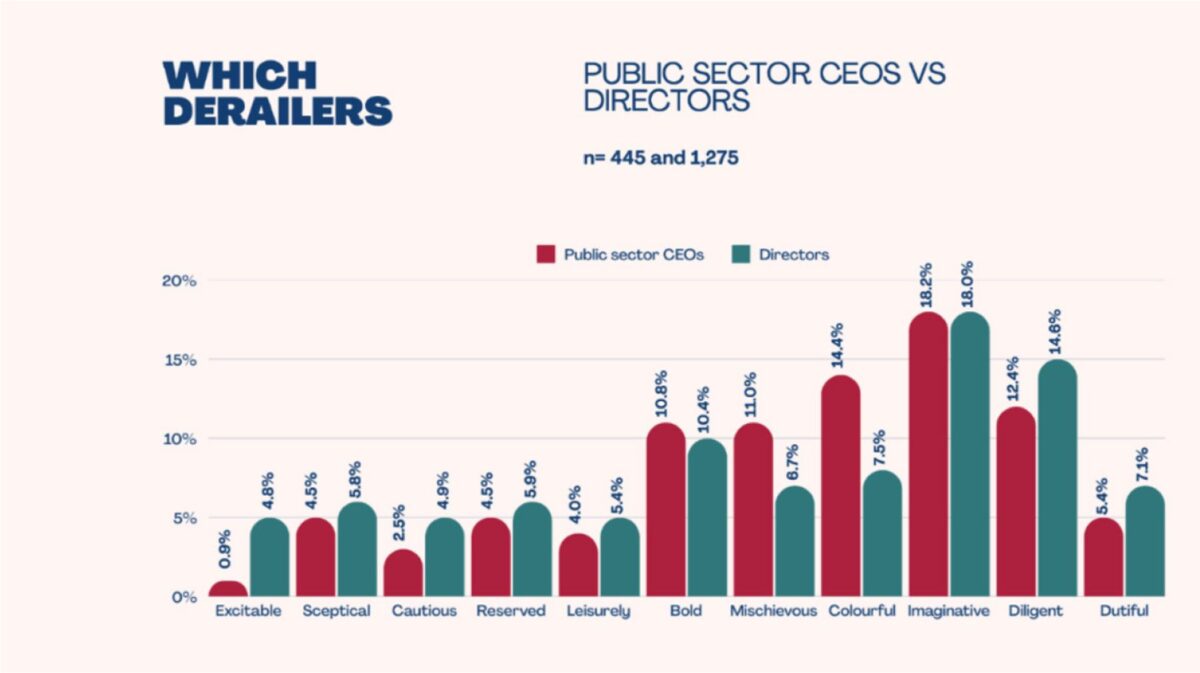
How do public sector CEO derailer risks compare to other public sector executives? This comparison group includes 1,275 participants in all executive level roles excluding the CEO position, labelled as Director for simplicity.
The differences that really stand out here are mischievous and colourful, where CEOs appear to show these derailers more frequently than their executive team colleagues.
Colourful relates to enjoying being in the spotlight, being energetic, gregarious and ideas oriented but has a potential dark side around being too self-absorbed, unwilling to listen to feedback or becoming overly dramatic. Perhaps we should not be surprised that public sector CEO roles, operating under intense scrutiny, will naturally attract those who enjoy, rather than endure, being the figurehead and centre of attention.
Mischievous relates to being charming but prone to seeking out excitement and risks; individuals with derailers in this area can potentially be seen as lacking sincerity or showing a casual disregard for others.
Interestingly, the bright side Altitude Behaviours that showed the strongest differences between CEO and other executive level applicants were engage and inspire, and influence and impact. These could be seen as the positive flipsides of these dark side behaviours.
This raises some interesting questions about whether the potential positive sides of these behaviours outweigh the potential risks. The current public sector landscape, with constant change and cross-organisational working demands these skills in engaging and influencing others for success; but do those who can do this well also bring risks?
4. CEO appointees vs Unsuccessful HDS high scores (Table 6)
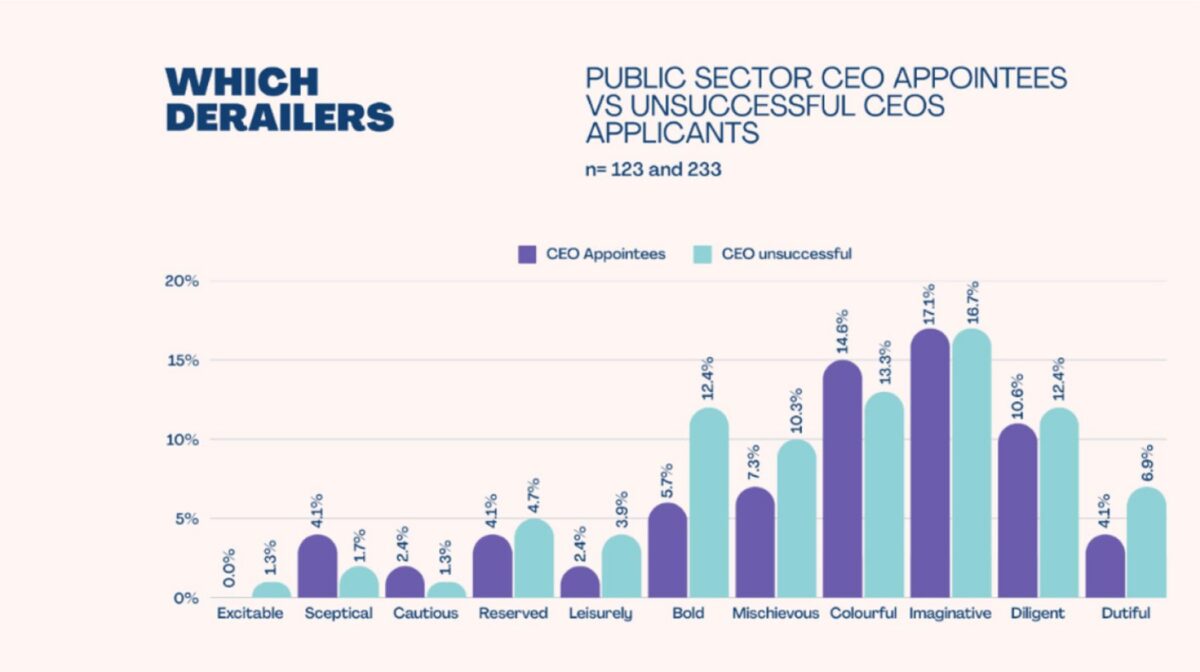
What are the key differences and similarities between successful and unsuccessful candidates? We compared the candidates who were ultimately successful in being offered the role they were applying for with those who did not receive an offer of employment.
There are two key findings worth mentioning here.
-
Firstly – The only significant difference we see is on the bold dimension – indeed successful candidates are 50% less likely to have high risk areas on this scale than unsuccessful candidates. Bold pertains to a sense of confidence which tips over into arrogance, a sense of entitlement and overplaying one’s own capability. High scorers also distance themselves from those who are in any way critical of them. It may be that these traits become evident to interview panels and may be a factor in them deciding not to appoint individuals.
-
Secondly – When examining the risk areas for those successfully selected, the dark side prominent patterns of the imaginative and colourful scales, seen in the full cohort of CEOs, are still present here. These traits do not dissuade panels from appointing, suggesting the positive sides of these scales, inspiring others and driving change through the organisation are considered to outweigh the potential risks of these personality traits, being dramatic and eccentric, respectively, when they are taken to the extreme.
Summary
To summarise the key findings from these comparison analyses, it seems that:
-
Public sector CEOs show fewer leadership derailers than their private sector counterparts, with a lower prevalence of ‘Moving Away’ derailers in particular.
-
The most common derailers among public sector CEOs are imaginative and colourful
-
These two derailers are still present in those who are successful in being offered a CEO position
-
Colourful and mischievous appear to be more prevalent as derailers in public sector CEOs compared to their executive team colleagues
-
Bold, a risk of becoming overly confident and ignoring criticism, is the key area which seems to lead to people being less likely to be appointed to the CEO role
The authors
- Marie Blakesley is a Chartered Psychologist, and Partner and Head of Assessment & Talent Consulting at GatenbySanderson Ltd.
- Gillian Hyde is Chief Psychologist at Psychological Consultancy Ltd.
The CFO Personality Report
Discover the behavioural traits that define high-performing CFOs and explore the dynamics that shape the CEO-CFO relationship.
Conflict of interest:
Gillian Hyde is Chief Psychologist at Psychological Consultancy Ltd, distributors of the Hogan series of assessments, including the Hogan Development Survey (HDS) .
References
-
Alimo-Metcalfe, B.M. & Alban-Metcalf, J. (2006). More (good) leaders for the public sector. International Journal of Public Sector Management, 19(4), 293–315.
-
Alimo-Metcalfe, B.M., Alban-Metcalfe, J., Bradley, M., Mariathasan, J. & Samele, C. (2008). The impact of engaging leadership on performance, attitudes to work and wellbeing at work: A longitudinal study. J Health Organ Manag, 22(6), 586–98. https://doi.org/10.1108/14777260810916560. PMID: 19579572
-
Koolma, H.M. & Dreven, C.F.V. (2019). The Change from the Creation to the Destruction of Public Value in Social and Institutional Contexts – A Case Study of CEO Peer and Policy Networks within the Dutch Social Housing Sector. Public Integrity, 21(6), 595–612. https://doi.org/10.1080/10999922.2019.1667690
